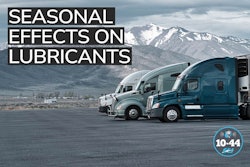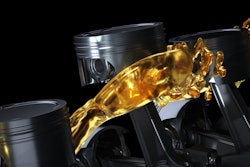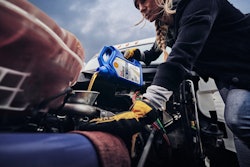Basically, for forever, fleets have used a straight 50 weight oil in their transmissions, but Gene Jensen, Chevron Lubricants’ Lubricants Trainer, points out transmissions have evolved – a lot – over the years, and OEMs decided that they want more flexibility and transmission fluids and in the process the number of available options for each transmission type increased three fold.
Jenson joins Jason and Matt this week on CCJ's 10-44 to talk transmission fluids, gear oils and coolant for some bumper-to-bumper coverage.
Contents of this video
00:00 Transmission fluids01:33 Selecting gear oil
02:10 OEM transmission market
04:22 Confusing transmission oil with gear oil
05:05 Seasonal demands of coolant
06:15 Sampling coolant
This week's 10-44 is brought to you by Chevron Delo 600 ADF ultra low ash diesel engine oil. It's time to kick some ash.
Jason Cannon
Fluids run from the front at the radiator to the rear in the differential of the vehicle. Is your fleet getting it all right?
Hey everybody and welcome back to the 10-44 a weekly webisode from the editors here at CCJ. I'm Jason Cannon and my co-host on the other side is Matt Cole. Basically for forever, fleets have used a straight 50 weight oil in their transmission. But Gene Jensen, Chevron Lubricants, lubricants trainer points out that transmissions have evolved and they've evolved a lot over the years. OEMs have decided that they want more flexibility from their transmission fluids and in the process, the number of available options for each transmission type has increased threefold.
Gene Jensen
The old way forever and ever. It was a synthetic 50 weight and that was the standard for a long, long time. And that 50 is an SAE, Society of Automotive Engineers 50 weight.
So what happened was is that, they didn't like that viscosity range, the manufacturers of transmission, they wanted a wider temperature range for seasonality reasons, and startup reasons. And the lighter the vis easier it is to start up and the less wear and all that kind of stuff.
So Volvo mat came up with a 75-80 multi viscosity. Okay? Eaton 75-90. Daimler 75-90. And guess what? The additives are all different. So we went from one product, straight 50 weight to three products for Volvo, Mac, Eaton, and Daimler.
Matt Cole
Everybody likes more options, right? Well, Gene says when it comes to gear oil, selecting the right one for the truck went from being an easy layup to more of an exact science.
Gene Jensen
So that just made things more complicated. And now they're multi viscosity and that is confusing as heck because what happens is the guys on the floor, they're out there, they've got a work order to change the transmission. They look at something like 75-90, they think that's a rear end oil, a gear oil for the rear end, when in fact it's a transmission. So this multi viscosity designation is very confusing.
Jason Cannon
Jean mentioned Volvo, Mac, Daimler, and Eaton, which pretty much covers the transmission market. Pretty much.
Gene Jensen
So there's getting to be more and more Allison transmissions out there for sure. And they're automatics and to kind of the various speeds, 13 speeds, whatever. Those are, you got to know what you're doing there. And automatic makes, we have a hard time getting drivers. And so maybe the skill level's not as much. So we're putting more and more automatics out there.
And so they just upgraded their spec on the fluid for transmission and the spec's called TES 668. And there are fluids out there that meet that spec too. So just be aware that transmissions, they, things have really changed and it's based on the manufacturer what type of fluid that they use. Interestingly, there's still the straight 50 [00:03:00] out there to confuse things even further.
Matt Cole
Gene mentioned just a minute ago that with the change in available viscosity, it's easy to confuse transmission oil with gear oil. So it's only fitting that we asked Gene about gear oil right after a word from 10-44 sponsor Chevron Lubricants.
Protecting your diesel engine and Its after treatment system has traditionally been a double-edged sword. The same engine oil that is so essential to protecting your engine's internal parts is also responsible for 90% of the ash that is clogging up your DPF and upping your fuel and maintenance costs. Outdated industry thinking still sees a trade-off between engine and emission system protection and Chevron was tired of it. So they spent a decade of R&D developing a no compromise formulation. Chevron Lubricants developed a new ultra low ash diesel engine oil that is specifically designed to combat DPF ash clogging. Delo 600 ADF with omnimax technology cuts sulfate ash by whopping 60%, which reduces the rate of DPF clogging and extends DPF service life by two and a half times. [00:04:00] And just think what you can do with all the MPGs you're going to add from cutting your number of regens. But Delo 600 ADF isn't just about after treatment. It provides complete protection extending drain intervals by preventing oil breakdown. Before you had to choose between protecting your engine or your after treatment system. And now you don't. 600 ADF from Delo with omnimax technology, it's time to kick some ash.
Gene Jensen
All right, so let's talk about gear oils a little bit. So just as in transmissions, things have changed. We used to have 75-90, w140, and that was a full synthetic, and that's the way it was for years and years. Okay, well then folks like Dana and Meritor and STEM Co, they wanted different added package, so we had to change that up. And then Daimler, they didn't like that. So they have a different set of additives and a different viscosity. They have a 75 W 85, so just be aware that the old standards of the old days have now changed to what the manufacturer is. And Daimler, if you have those kind of [00:05:00] rear ends, that's a special viscosity oil that's different from the others.
Jason Cannon
It doesn't have much to do with the drive line. But as we round the corner into April, Gene wanted to take the opportunity to remind fleets out there that the demands of your cooler are about the change. And a lot like transmissions and gear oils, there's a lot of options out there. And with options comes the probability of getting it wrong.
Gene Jensen
So as we move into warmer times of year, the cooling capability of the system is becomes more of an issue. So [00:05:30] let's go to the sub fundamentals of cool. What moves the heat? The best heat transfer or fluid, one of the best one known is water. Water has problems. It freezes, it boils, and it corrodes. So let's talk about the seasonality deal. The freezings, what we do is we put ethylene glycol in there. Now there's propylene glycol and other things out there, but the vast majority of it is ethylene glycol. And so the ethylene glycol lowers the freeze point substantially. We typically see a 50/50 blend now up in Canada and some places like that. In Alaska, you'll see a 60/40 where 60% of it is actually ethylene glycol. But what happens is when you get past that, when in other words, straight ethylene glycol is not a very good heat transfer, you will overheat an engine with straight coolant.
Matt Cole
As a part of basic preventive maintenance. Gene says fleets need to take a sample and analyze with a refractometer, not one of those cheap ball and float tools and adjust levels accordingly.
Gene Jensen
You go in there and you take a sample and you take a refractometer and you check the percentage of glycol. Sometimes it shows as freeze point or it may show as percentage of glycol. But what happens is all these systems they leak a little bit with. When they're nice and warm that water goes out of there first and by and by, you keep adding and adding and adding, whether you're adding concentrate or whether you're adding 50/50, most people would probably add the 50/50. Little by little the percentage of glycol increases because [00:07:00] it's the water that's getting out of there. So almost every time, when I've looked at it, when you're looking at seasonality as you're moving into the summer and you look at that refractometer, a little bit of water snuck out of there, and so you have too much glycol, and so your cooling capability has gone down.
Jason Cannon
That's it for this week's 10-44. You can read more on ccjdigital.com, and as always, you can find the 10-44 each week on CCJs YouTube channel. And if you've got questions, comments, criticisms, or feedback, please hit us [00:07:30] up at [email protected] or give us a call at 404-491-1380. Until next week, everybody stay safe.










